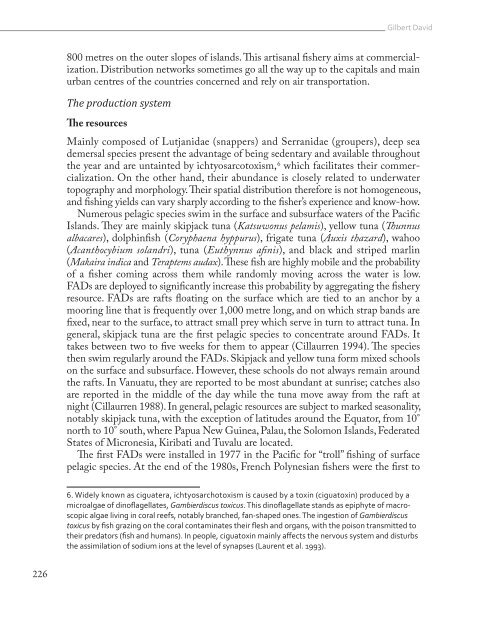Fisheries in the Pacific
Fisheries_in_the_Pacific
Fisheries_in_the_Pacific
You also want an ePaper? Increase the reach of your titles
YUMPU automatically turns print PDFs into web optimized ePapers that Google loves.
Gilbert David<br />
800 metres on <strong>the</strong> outer slopes of islands. This artisanal fishery aims at commercialization.<br />
Distribution networks sometimes go all <strong>the</strong> way up to <strong>the</strong> capitals and ma<strong>in</strong><br />
urban centres of <strong>the</strong> countries concerned and rely on air transportation.<br />
The production system<br />
The resources<br />
Ma<strong>in</strong>ly composed of Lutjanidae (snappers) and Serranidae (groupers), deep sea<br />
demersal species present <strong>the</strong> advantage of be<strong>in</strong>g sedentary and available throughout<br />
<strong>the</strong> year and are unta<strong>in</strong>ted by ichtyosarcotoxism, 6 which facilitates <strong>the</strong>ir commercialization.<br />
On <strong>the</strong> o<strong>the</strong>r hand, <strong>the</strong>ir abundance is closely related to underwater<br />
topography and morphology. Their spatial distribution <strong>the</strong>refore is not homogeneous,<br />
and fish<strong>in</strong>g yields can vary sharply accord<strong>in</strong>g to <strong>the</strong> fisher’s experience and know-how.<br />
Numerous pelagic species swim <strong>in</strong> <strong>the</strong> surface and subsurface waters of <strong>the</strong> <strong>Pacific</strong><br />
Islands. They are ma<strong>in</strong>ly skipjack tuna (Katsuwonus pelamis), yellow tuna (Thunnus<br />
albacares), dolph<strong>in</strong>fish (Coryphaena hyppurus), frigate tuna (Auxis thazard), wahoo<br />
(Acanthocybium solandri), tuna (Euthynnus af<strong>in</strong>is), and black and striped marl<strong>in</strong><br />
(Makaira <strong>in</strong>dica and Teraptems audax). These fish are highly mobile and <strong>the</strong> probability<br />
of a fisher com<strong>in</strong>g across <strong>the</strong>m while randomly mov<strong>in</strong>g across <strong>the</strong> water is low.<br />
FADs are deployed to significantly <strong>in</strong>crease this probability by aggregat<strong>in</strong>g <strong>the</strong> fishery<br />
resource. FADs are rafts float<strong>in</strong>g on <strong>the</strong> surface which are tied to an anchor by a<br />
moor<strong>in</strong>g l<strong>in</strong>e that is frequently over 1,000 metre long, and on which strap bands are<br />
fixed, near to <strong>the</strong> surface, to attract small prey which serve <strong>in</strong> turn to attract tuna. In<br />
general, skipjack tuna are <strong>the</strong> first pelagic species to concentrate around FADs. It<br />
takes between two to five weeks for <strong>the</strong>m to appear (Cillaurren 1994). The species<br />
<strong>the</strong>n swim regularly around <strong>the</strong> FADs. Skipjack and yellow tuna form mixed schools<br />
on <strong>the</strong> surface and subsurface. However, <strong>the</strong>se schools do not always rema<strong>in</strong> around<br />
<strong>the</strong> rafts. In Vanuatu, <strong>the</strong>y are reported to be most abundant at sunrise; catches also<br />
are reported <strong>in</strong> <strong>the</strong> middle of <strong>the</strong> day while <strong>the</strong> tuna move away from <strong>the</strong> raft at<br />
night (Cillaurren 1988). In general, pelagic resources are subject to marked seasonality,<br />
notably skipjack tuna, with <strong>the</strong> exception of latitudes around <strong>the</strong> Equator, from 10°<br />
north to 10° south, where Papua New Gu<strong>in</strong>ea, Palau, <strong>the</strong> Solomon Islands, Federated<br />
States of Micronesia, Kiribati and Tuvalu are located.<br />
The first FADs were <strong>in</strong>stalled <strong>in</strong> 1977 <strong>in</strong> <strong>the</strong> <strong>Pacific</strong> for “troll” fish<strong>in</strong>g of surface<br />
pelagic species. At <strong>the</strong> end of <strong>the</strong> 1980s, French Polynesian fishers were <strong>the</strong> first to<br />
6. Widely known as ciguatera, ichtyosarchotoxism is caused by a tox<strong>in</strong> (ciguatox<strong>in</strong>) produced by a<br />
microalgae of d<strong>in</strong>oflagellates, Gambierdiscus toxicus. This d<strong>in</strong>oflagellate stands as epiphyte of macroscopic<br />
algae liv<strong>in</strong>g <strong>in</strong> coral reefs, notably branched, fan-shaped ones. The <strong>in</strong>gestion of Gambierdiscus<br />
toxicus by fish graz<strong>in</strong>g on <strong>the</strong> coral contam<strong>in</strong>ates <strong>the</strong>ir flesh and organs, with <strong>the</strong> poison transmitted to<br />
<strong>the</strong>ir predators (fish and humans). In people, ciguatox<strong>in</strong> ma<strong>in</strong>ly affects <strong>the</strong> nervous system and disturbs<br />
<strong>the</strong> assimilation of sodium ions at <strong>the</strong> level of synapses (Laurent et al. 1993).<br />
226


